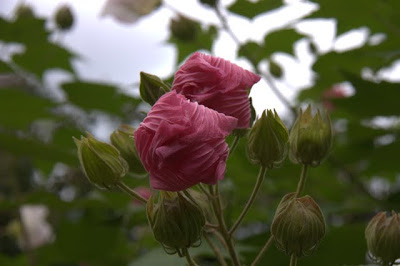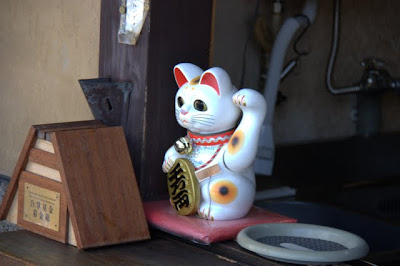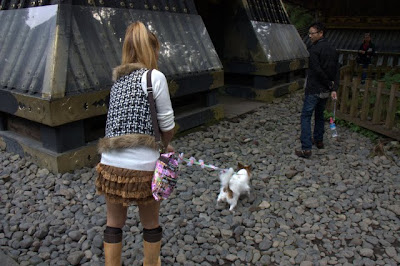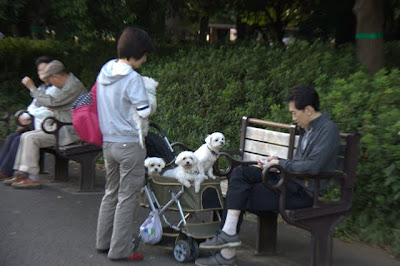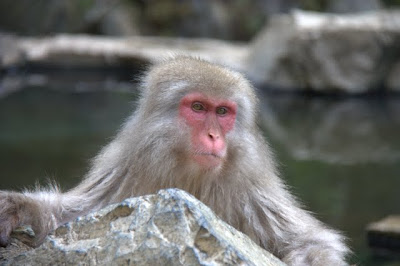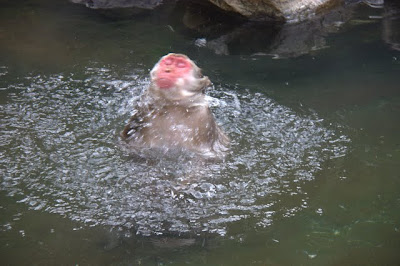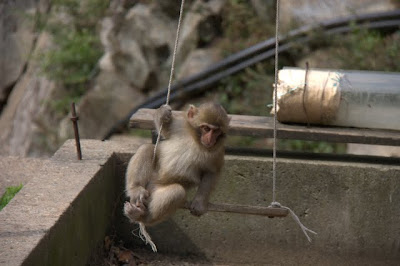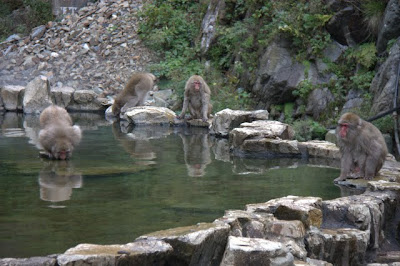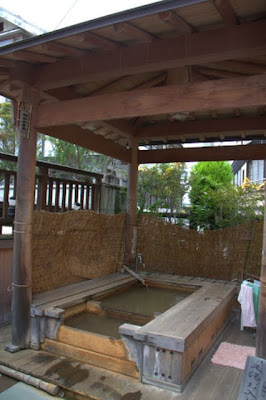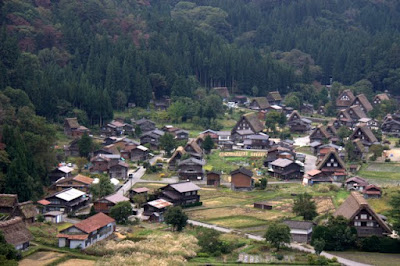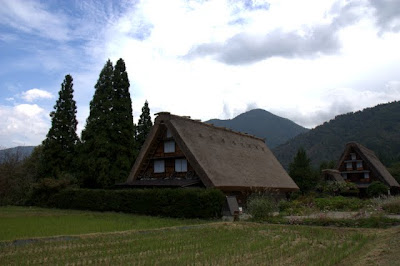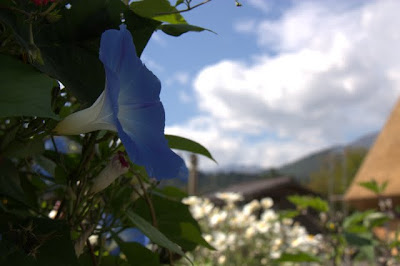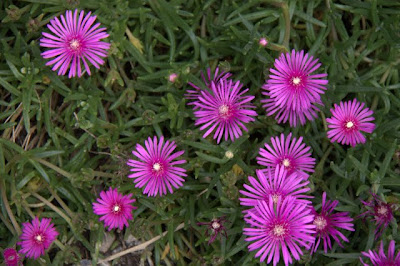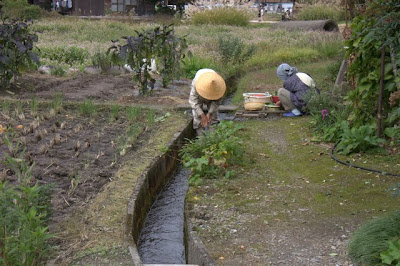The Precipice of Koyo
Like watching cherry blossoms in the spring, viewing koyo – autumn foliage – is a national pastime in Japan in the fall. The weather person reports on the best koyo, and websites track the progress all over the country. Without going way north, we were there just a tad too early (the last week of September through the third week in October). The weather grew from warm to cool while we were there, and everything felt like it was on the verge of turning to full blown fall, but the elusive koyo failed to materialize. Meanwhile, all around us were advertisements for the best koyo spots, showing the landscapes ablaze in firey reds and oranges. I kept my eye out wherever we went. We managed to spot a few places where the leaves had turned, but nothing like the posters.
In the Japanese gardens, everything felt like it was on the precipice of fall, but not quite there yet.
It was comforting to be somewhere where the season aligned with the season at home. Not that I’d want to trade places on the basis of weather now!
Raise your paw high
Some places are dog places, other are cat places. Japan seemed to be a cat place. Cats popped up in the most unexpected places in Japan:
And, as you’ve already seen, but worthy of a repeat…
The Japanese believe that a cat with its paw raised high in the air brings them good fortune and money. All over Japan, we saw cats in front of stores with their paws moving up and down over and over.
As further evidence, I present to you this poster depicting a painting by a Japanese artist in Ueno Park:
And of course, there’s the whole Hello Kitty obsession.
Then again, maybe the Japanese are dog people after all.
Monkeys…in hot tubs!
Japanese people are not the only ones who love to take onsen. High in the mountains outside of Nagano, macque snow monkeys also love the hot healing waters. We took a day trip from Kamesei Ryokan in Chikuma City to visit Jigokudani Monkey Park to see this unusual behavior for ourselves.
We were warned over and over not too look the monkeys in the eyes, because they see eye contact as a form of aggression. Of course, the first thing Sean and I did when we unexpectedly encountered a monkey near the entrance was look it in the eye. It started coming towards us. I shrieked. Sean ran, leaving me in a standoff with the monkey. Glad to see I have a protector. I inched my way around the monkey, and we notified the guy at the entrance desk that the monkey seemed agitated. He came out in a hurry, but upon seeing a monkey just hanging out in the corner, he shooed it away and told us not to worry. Meanwhile, all of the Japanese visitors inside the building watched all of this play out through the glass and were getting a hearty chuckle over the silly scared Americans.
On the path down to the onsen, we muttered don’t look him in the eye, don’t look him in the eye every time we passed a monkey. Once we arrived to the onsen, we had to get over our fears of the monkeys quick, because they surrounded us on all sides, doing what monkeys do. Viewing these monkeys, I have no doubts about people’s scientific relationship to primates. Our friend Tony calls our cat a humanoid due to his tendency to act super fabulous and people-like. There is no other way to describe these monkeys except for little humanoids. They lounged, ate, swam, soaked, and cuddled just like humans.
We were a little disappointed, because the monkeys seemed to enjoy being in the onsen most when the park ranger enticed them in by throwing food. Perhaps it was because the weather wasn’t cold; I’ve heard the best time to view the monkeys is in the snowy winter months. Nevertheless, the monkeys were still fun to watch. And if I want to see what they are up to this winter, all I need to do is to check out the monkey’s webcam; live monkey action 24/7.
How do you say awkward in Japanese?
Hot springs bubble all over Japan, and the Japanese have tapped into most of them to create onsens. Entire towns have sprung up around the hot springs, filled with public onsens and private ones in ryokans (traditional Japanese inns). We even saw people soaking their feet in an onsen foot bath in the center of town. I’d heard that people stroll around town in their yukata robes and wooden geta sandals, but we didn’t see this in any of the onsen towns we visited.
I’ve been dying to try a hot spring ever since we visited Colorado a couple of years ago and didn’t get a chance to go to any of the hot springs. I wasn’t going to be deterred in Japan, even after I learned that onsens have a complicated set of rules. First, there’s the whole rule about not wearing clothes. Me, pasty pale and flabby in a hot spring full of naked trim Japanese women. Um, awkward! Then there’s the whole rule about making sure nothing impure goes into the onsen, which means you have to scrub down publically at a sit-down bath/shower contraption before you enter the water. Fun times. Neither Sean nor I had a choice when we stayed at a ryokan in an onsen town in the Nagano prefecture; the only bath was the public one in the onsen room.
After I survived the onsen at the relatively uncrowded ryokan, Sean and I split up for the day so I could voluntarily subject myself again to the onsen. I visited the popular onsen Tenzen in Hakone. This time, there was no hoping and praying that you were the only one who decided to use the onsen at the moment. I tried to relax in the onsen’s steamy sulphur waters, which are said to have healing properties, but couldn’t get my mind off of the fact that I was surrounded by at least thirty naked Japanese women. When a mother started undressing her children in the changing room to bring them into the onsen, I couldn’t hightail it out of there fast enough. While the Japanese are completely comfortable with this public form of bathing – some of them even using it as their sole method of cleansing themselves – I still prefer my very private shower. I hope the Colorado hot springs allow bathing suits.

Tenzen's grounds. Obviously I don't have any pictures of the onsen baths themselves. The only thing more awkward than an anxious naked American girl would be an anxious naked American girl with a camera.
Shirakawa-go
High up in the Japanese Alps sits a little village called Shirakawa-go. There, because of the snow that falls every winter, villagers built homes with steeply pitched thatched roofs. The quaint little mountain town is a World Heritage site. Although tourists, mostly Japanese, traipse through the town, people still live there, lighting fires on the first floors for warmth and nurturing silk cocoons on the second floors for income. The day we visited, a house’s roof was being re-thatched. We went to Shirakawa-go to see the houses, but I found another pleasant surprise. The town is bursting with flowers, meaning that I ended up with just as many pictures of the flowers as the houses.






